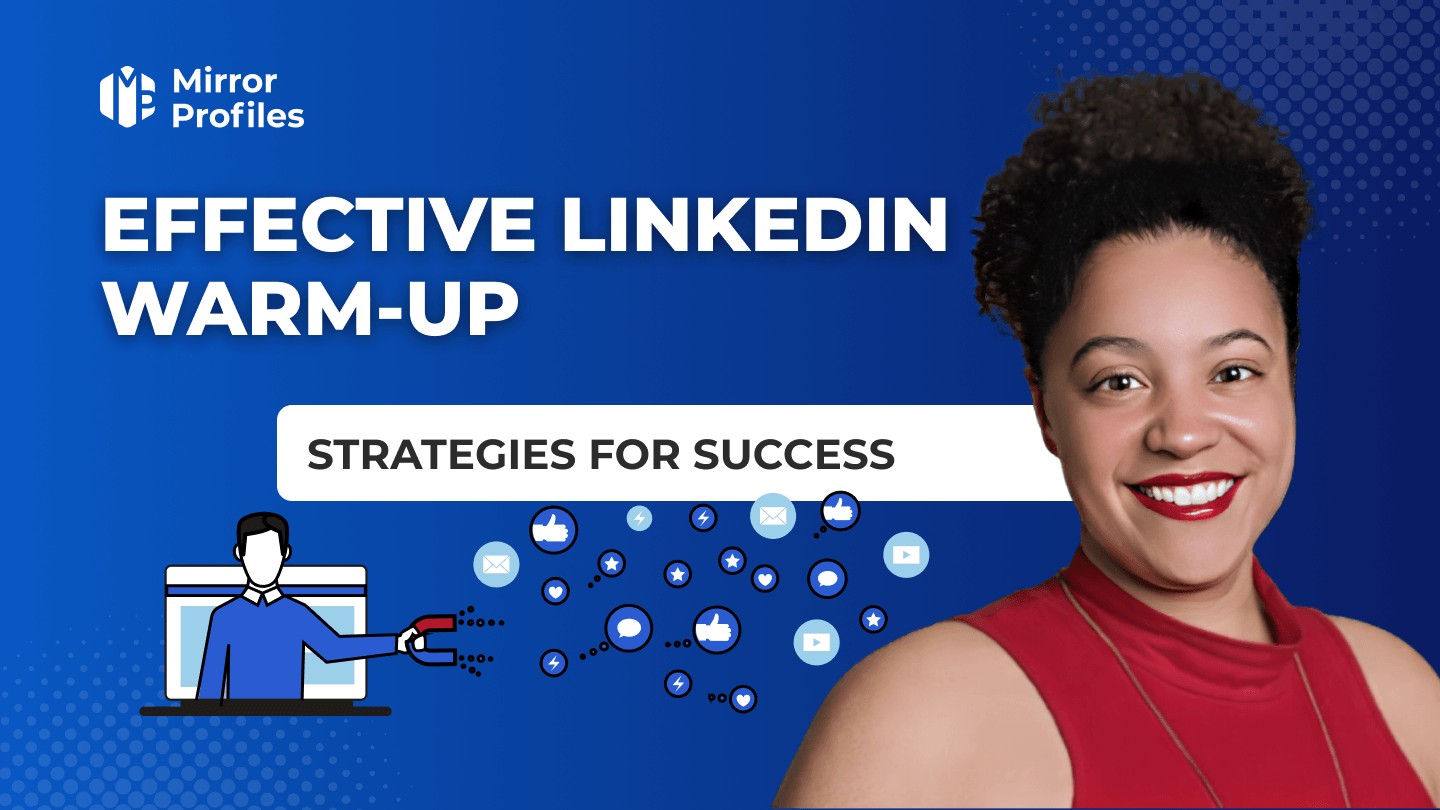Introduction
Spin selling is an innovative approach to Linkedin prospecting, particularly effective for complex transactions. By focusing on the customer’s concerns and challenges, this method helps to build relationships based on trust, and to propose solutions that are perfectly adapted to the needs identified. Its effectiveness is based on a series of strategic questions that explore a prospect’s situation and problems in depth, the better to steer the discussion towards beneficial solutions. Coupled with several Linkedin MirrorProfiles accounts, spin selling is particularly effective.
In effect, you’ll use one of your accounts for the prospect’s questions, and another account for the problem-solving part. On the account that will question your prospect you can personalize it like a student, and for the second (who will be employed in your company) you’ll send them a message of perfect precision and timing.
What is spin selling?
Spin selling is a sales method developed by Neil Rackham in the 1980s. Designed for complex, long-cycle businesses, this approach stands out for its effectiveness in understanding and responding to deep-seated consumer needs. Unlike traditional techniques that focus on the product, spin selling focuses on the buyer and his or her issues.
The concept is based on four types of strategic questions, represented by the acronym SPIN:
- Situation: These questions aim to understand the customer’s current situation. They enable us to gather basic information about the company, the processes in place, and the challenges encountered. For example, “What is your current strategy for achieving your sales targets?” Or “What tool do you use to prospect on Linkedin?”
- Problem: Here, the aim is to highlight the specific difficulties encountered by the customer. These questions help identify obstacles and areas of friction. For example, “What are the main challenges you face in driving your sales pipeline?”
- Implication: These questions encourage the customer to think about the consequences of unresolved problems. They help intensify the perception of urgency and the importance of finding a resolution. For example, “How are these difficulties impacting the overall performance of your sales team?”
- Need-payoff: Finally, these questions lead the customer to consider the benefits of a solution. They focus on the specific advantages that the proposed product or service could bring. For example, “How could implementing an automated management system improve your sales results?”
The effectiveness of spin selling lies in its ability to transform the sale into an exploratory conversation, focused on the customer’s real needs. For a born salesperson, it’s instinctive, but we call it “customer discovery”. By asking the right questions, the salesperson can not only establish a relationship of trust, but also guide the customer towards an awareness of their needs and the added value of the proposed solution.
Why use spin selling in your sales cycle?
Spin selling isn’t just one method among many, it’s a revolution in the way we approach sales. Its use offers several key advantages, making it an essential tool for sales teams seeking to maximize their efficiency and results. What’s more, with the Mirrorprofiles technique explained in the introduction, this amounts to a kind of reverse ABM strategy. On average, our customers who use this method have tripled their rate of appointments.
An in-depth understanding of needs
By using spin selling, salespeople are able to get to the heart of consumers’ concerns. Thanks to situative questions, they draw up a precise picture of the context and the specific challenges faced by the customer. This not only enables us to better understand needs, but also to propose truly adapted solutions. Your product / service meets a real need, so there’s no need to invent it 😉
Strengthening the relationship of trust
Problem and involvement questions encourage customers to open up and share their difficulties. By actively listening and demonstrating genuine empathy, salespeople build a solid relationship of trust. This trust is crucial for complex businesses, where the buying decision is often based on the credibility and reliability of the seller.
Speed up the decision-making process
By raising awareness of the negative implications of unresolved problems, spin selling creates a sense of urgency in the customer. The need and benefit questions help to visualize the advantages of the proposed solution in concrete terms, speeding up the decision-making process. The customer clearly sees the added value and is more inclined to take action.
Adaptability and customization
Every customer is unique, and spin selling enables us to tailor our sales approach to the specificities of each situation. This flexibility is essential for adapting to different contexts and consumer types, thus increasing the chances of success.
A proven method
Spin selling is based on in-depth research and analysis of thousands of transactions. Its effectiveness has been proven. Many companies have adopted it into their processes, and are seeing a significant improvement in their sales performance.
In short, using spin selling means adopting a customer-centric process that emphasizes listening and understanding. It’s an effective way to turn a prospect into a satisfied customer, while building long-lasting, profitable relationships.
How can you incorporate spin selling into your prospecting?
Putting the spin selling process into practice requires a structured approach and good preparation. Here’s how to use it effectively:
1. Preparation: Before meeting the customer, the first step is to be well prepared. Gather all available information on the company, its market, competitors and potential challenges. Also prepare a list of relevant questions for each SPIN category (Situation, Problem, Involvement, Need-payoff).
To save time, segment your clientele into several targets so you have a framework of questions that form the basis of your discovery. Then your sales representative will have to adapt all this to the customer’s situation. Of course, avoid being over-prepared, as over-preparation often makes messages or discussions robotic and impersonal.
2. Ask situational questions: Start by asking situational questions to understand the customer’s overall context. These questions should be open-ended, aimed at obtaining basic information about the company and its operations. For example:
- “Can you describe your current sales management process?”
- “What tools do you currently use to track your sales performance?”
3. Identify problems: Next, ask problem questions to discover the specific difficulties the customer is experiencing. Look for pain points and obstacles. For example:
- “What are the main challenges you face in qualifying leads?”
- “Do you find it difficult to maintain a constant pipeline?”
4. Explore the implications: Once the problems have been identified, explore their implications by asking questions that encourage the customer to think about the negative consequences of these problems. These questions should help the customer understand the importance of finding a solution. For example:
- “How do these difficulties affect the overall performance of your sales team?”
- “What would be the financial impact if these problems persisted?”
5. Highlight the benefits: Finally, ask need-payoff questions to help the customer see the concrete benefits of a solution. These questions should show how your product or service can solve their problems and add value. For example:
- “How could better lead management improve your sales results?”
- “How could automating your sales processes help you reach your goals faster?”
6. Adapt your sales pitch: Every customer is different, so it’s crucial to adapt your sales pitch to the answers you get. Be flexible and ready to adjust your approach to meet the exact needs expressed by the customer.
7. Conclude effectively: Use the information gathered to formulate a clear and convincing value proposition. Show how your solution is the best answer to the customer’s problems and needs. Be specific and make sure the customer understands the tangible benefits of your offer.
By following these steps, you can use spin selling effectively to build strong relationships with your customers and increase your chances of closing sales.
MirrorProfiles to help you spin selling
MirrorProfiles is a service specializing in the rental of professional-quality LinkedIn accounts dedicated to B2B prospecting. This innovative solution enables you to optimize your sales strategies, in particular by applying the principles of spin selling. Here’s how MirrorProfiles can help you convert a lead into a prospect using the SPIN method:
MirrorProfiles lets you manage several LinkedIn accounts, each dedicated to a specific sector or lead type. This verticalization helps you personalize your approach and deliver relevant content to each prospect. By applying spin selling, you can tailor your situation, problem and involvement questions to the particularities of each sector, increasing your chances of conversion.
With several LinkedIn MirrorProfiles accounts, you can go beyond the limits of LinkedIn and contact as many people as possible. By automating your prospecting with invitations and messages, you can considerably increase your reach. This means you can ask SPIN questions to a greater number of prospects, maximizing the opportunities to discover their specific needs and propose appropriate solutions. This method requires a lot of Linkedin quota, as you ideally need to double your connection requests for each prospect.
By using dedicated accounts for prospecting, you protect your personal LinkedIn account from being banned. This guarantees continuity in your prospecting activities without compromising your personal profile. So you can continue to apply SPIN techniques with complete peace of mind, safe in the knowledge that your main account is secure.
MirrorProfiles lets you effectively manage your leads with MirrorCRM. You can store them and synchronize them with your CRM, ensuring optimal management of your sales pipeline. SPIN questions can be tracked and used to nurture your leads and support them throughout their buying journey. Even if you stop using MirrorProfiles, your data remains accessible, enabling you to continue interacting with your leads in a personalized and strategic way.
In conclusion, spin selling is a revolutionary approach to sales, particularly effective for complex transactions. By focusing on a customer’s concerns and challenges, this method helps to build relationships based on trust, and to propose solutions that are perfectly adapted to the needs identified. This is a great technique for generating leads on Linkedin. Its effectiveness is based on a series of strategic questions that explore a prospect’s situation and problems in depth, the better to steer the discussion towards beneficial solutions.
By using spin selling, you can turn sales conversations into genuine needs explorations, reinforcing trust and collaboration. It’s a proven method that not only speeds up the decision-making process, but also allows you to tailor your approach to each customer, increasing your chances of success.
What’s more, with tools like MirrorProfiles, you can optimize your prospecting strategies and maximize the effectiveness of spin selling. By multiplying your contact points, protecting your personal LinkedIn account, and effectively managing your leads, MirrorProfiles helps you implement a more robust and flexible SPIN approach.
In short, the combination of spin selling and solutions like MirrorProfiles is a major asset for any sales team looking to improve performance and build lasting, profitable customer relationships. Adopt these strategies to turn your prospects into satisfied, loyal customers.





